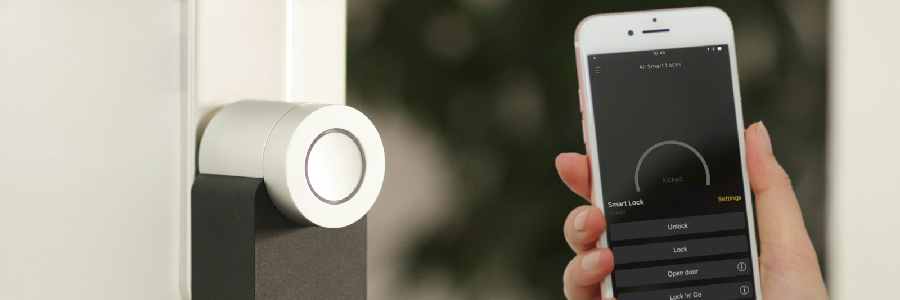Got an old lock that looks like it’ll give out at any moment? Or maybe you’re considering a deadbolt replacement to keep up with the times and give your home a much-needed security upgrade. If this is the case for you, Okey Locksmith in Oklahoma City has the expertise to guide you through the process. Here, we’ll break down how smart locks work, how to choose the right one, and how to install smart locks and integrate them into your smart home network.
What Are Smart Home Locks?

Smart locks work by letting you lock and unlock your doors using your phone (through an app), keypad, or even voice control or commands. They connect to your home Wi-Fi network and Bluetooth, as well as other smart devices. This means you can grant access to guests, monitor who enters and exits, and even set your doors to automatically lock at specific times.
Compared to a physical lock, smart locks are incredibly versatile and convenient, especially for people or homeowners who leave the house often or need constant access to their front door locks through other means aside from physical keys.
How to Choose the Right Smart Lock for Your Home

Thinking of replacing your existing deadbolt with a smart door lock? The best smart locks are those that fit your household’s needs and preferences best. But to help you narrow down your options, let’s go over some important things to consider when taking your pick.
Firstly, you have to remember that not every lock fits every door, so you should choose a smart lock based on its compatibility with your door. Check the thickness of your door and the existing lock setup to make sure the smart lock you’re thinking of buying can be installed properly, especially if you’re opting for a full replacement lock. Some smart lock models like retrofit lock types are actually designed to fit over existing deadbolts, while others require a complete replacement.
Another thing to keep in mind is the connectivity options offered by your new smart lock. Most smart locks connect via Bluetooth, Wi-Fi, or Z-Wave/Zigbee. Bluetooth models are easy to set up and are battery-powered. These devices usually have a long battery life, though they do have a limited Bluetooth range. Wi-Fi locks, on the other hand, offer remote access but may drain batteries faster. Z-Wave and Zigbee locks require a compatible smart home hub but still provide reliable connections and extended features.
Key Features of Smart Locks
There are far too many smart locks to choose from, and each type has a lot of great smart features. So, the best thing to do is to consider which exact features are most important to you and prioritize those smart lock models.
1. Keyless Entry

One of the reasons why many homeowners choose smart locks is because of how versatile they are. In contrast, the standard lock can only be unlocked with physical keys. If you lose your keys (it happens to the best of us) and you don’t have a backup key anywhere, you’re going to need a locked-out-of-the-house locksmith. This can be a hassle to most people, which is why keyless entry is a strong selling point for smart locks.
You can use a code or your phone (via an app) to access and control your smart locks. There are also other options like the fingerprint scanner or fingerprint reader, voice control, two-factor authentication, and so on.
2. Auto Lock/Unlock

With smart locks, you can automatically lock or unlock your door remotely at any time or after a certain period. It can also automatically unlock when it detects your presence. How’s that for convenience?
Its auto-unlock feature is perfect for when your hands are full (e.g., carrying groceries, luggage, or a baby), which saves you the hassle of fumbling for keys or your phone to get your door open. The auto-lock feature is also a great security feature because it locks by itself after a certain period, so that even if someone accidentally leaves the door unlocked, this feature has your back!
3. Integration

What makes smart locks special is their smart home integration feature and Wi-Fi connectivity. Basically, this means you can connect your lock with your existing home system like Amazon Alexa, Google Assistant, or Apple HomeKit. You can utilize smart features like tamper alarms, real-time notifications about who enters when, and just a wide range of remote access options that can really come in handy.
4. Guest Access

Are you expecting guests but can’t be there on time when they arrive? No problem. Smart locks let you grant temporary access codes to visitors. So, even if you’re not home, your guest can just punch in that specific code, and the door will unlock to let them in!
How to Install Smart Locks
If you’re ready to replace your existing lock hardware and install a smart lock in its place, here’s a general rundown of the installation process. Don’t worry—most smart locks are quite easy to install and don’t require rewiring or serious door modifications. So, as long as you’re comfortable using basic tools, this installation will be straightforward for you!
Step 1: Remove Your Old Lock

The first step is to remove your existing deadbolt mechanism. Don’t forget to keep your screws, mounting plate, and strike plate in case you need it later.
Step 2: Install the Smart Lock

Most smart lock brands and models come with specific instructions. But generally speaking, you need to attach the new deadbolt, connect the front and back pieces, and secure them into place with the provided screws. Ideally, this will be a quick step, but there are instances when the new deadbolt won’t latch properly because the door isn’t in line with the door frame. So make sure they’re both level before installing!
Step 3: Connect It to Your Home Network

Now comes the techy part! Connect your smart lock to your home network and any other devices that it needs to communicate with. Depending on your specific smart lock, you can usually connect it to your phone, Apple Watch, and other smart home devices. To do this, you might have to download an app and follow the setup procedures to connect your lock to your Wi-Fi network or smart home hub.
Step 4: See if It Works

Once everything is hooked up, it’s time to start testing smart locks! Test it several times to make sure it locks and unlocks both manually and via your chosen method (e.g., phone app, voice command, fingerprint scanning, keypad, Google Assistant, Google Home App, etc., and can also support Apple Home Key.)
How to Integrate Smart Locks into Your Smart Home
The real magic of smart locks comes into play when they’re part of a larger smart home system. Here’s what you should know about smart home integration to make the most out of your new lock:
1. Use a Central Hub

If you have a Wi-Fi hub or smart home hub like Samsung SmartThings, Amazon Alexa, or Google Home, connect it to your smart lock. Doing this lets you control the lock along with your other smart devices from one app.
2. Automation

You can set up automation to make your life easier. An example is setting up your smart lock so it turns on your lights when you unlock the door at night.
3. Security Systems

For even more enhanced security, connect your smart lock to your smart security system. This can allow features like disabling the alarm when the door is unlocked with the right code or fingerprint.
How to Maintain Smart Locks

When you install a smart lock, don’t forget to keep it in great shape with these top tips:
1. Regular Updates
Like any technology, keeping the software up to date gives you the best security and functionality from your smart locks.
2. Battery Checks
Most smart locks run on batteries. Check them regularly to see if they need replacements soon. We recommend stocking up on batteries so you can just pop them in as soon as you realize that the old batteries are running low.
3. Regular Cleaning
Keep the lock clean from dust as much as possible, especially the keypad and fingerprint scanner. This way, your smart lock works as intended.
Okey Locksmith: Your Partner in Smart Home Security
Upgrading to a smart lock is a big step toward a more connected, secure home. If you need expert advice or locksmith services in OKC, we’re here to help you keep your home safe—and smart!
Get in touch with the pros today!










